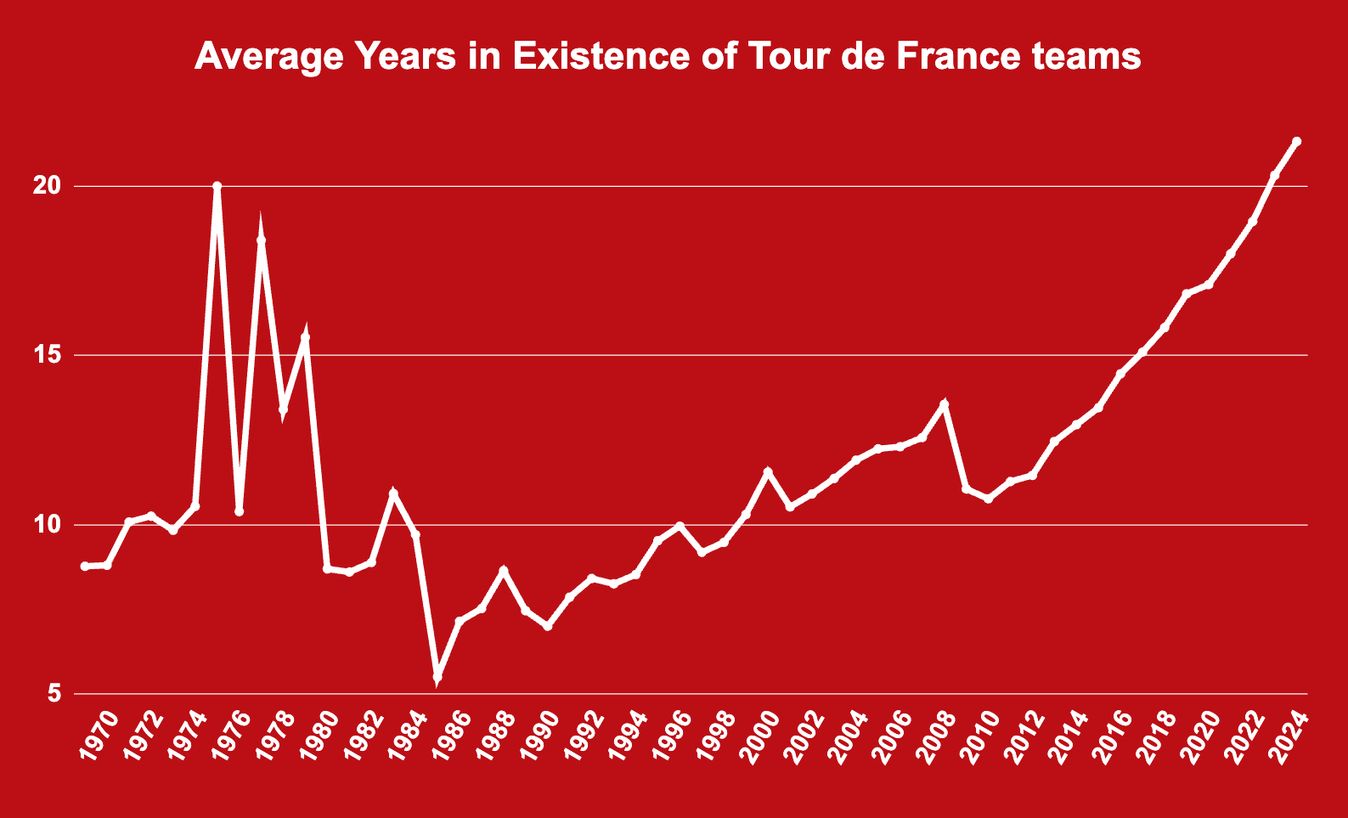Stat Attack: Does pro cycling really need saving?
Despite the latest push for a new financial model, the numbers show there's more stability than ever
Cillian Kelly
GCN's stat expert
© Sirotti Stefano
Teams are calling for more stability, but the stats show that the peloton has never been more stable
Does cycling need to be saved? Does it really need a new financial model in order to survive?
One Cycling is the latest in a line of ventures that purport to rescue men’s professional cycling from the financial doldrums and to provide stability that would make sponsorship investment in the sport a much more attractive proposition.
The main goals of all of these ventures tend to be simplifying the race calendar, making all the top riders race each other as often as possible, and pulling up the ladder to the lower tiers of teams so that the top tier becomes fixed – more like a league of American franchise teams.
Read more: Could Saudi Arabia soon own a large slice of cycling? - GCN Racing News Show
In short, the rumoured One Cycling project is no different. Reportedly backed by the Saudi Arabian Public Investment Fund, and headed up by Visma-Lease a Bike's Richard Plugge, the reform project wants to trim the cycling calendar to around 100 days, ensure the likes of Tadej Pogačar and Jonas Vingegaard face one another more often, and remove the monopoly that a few race organisers have on cycling's business model.
But is this all really necessary?
Winding back the clock
There was a time in cycling’s long history when the notion of a cycling team was fleeting. Here this year, gone the next. The turnover of teams – not just the sponsors of teams but the teams themselves – was a constant problem. Entire organisations, along with their collections of riders, would evaporate in winter and be reabsorbed and redistributed to other teams in time for the following spring.
But that was decades ago. Given the non-permanent nature of teams, a significant measure of the current stability of men’s professional cycling is the average number of years that teams have existed.
Read more: Stat Attack: The history Primož Roglič must defy to win the Tour de France
Let’s consider this number back as far as 1969 – this is the year that national teams were finally scrapped at the Tour de France. Since then, the structure of teams and how they exist within the sport hasn’t really changed. The notion of a top tier of teams, as we know it now, hasn’t always been the same since 1969, though. So let’s consider all of the teams that have taken part in the Tour de France each year.
Below is a graph showing exactly this: the average number of years each Tour de France team has existed.

© GCN
The trend is positive when it comes to teams' lifespans
For this year, 2024, the average length of time that a Tour de France team has been in existence will be 21.32 years – a figure that has never been higher.
Decathlon AG2R La Mondiale have been around for 32 years. Cofidis and Groupama-FDJ, not far behind, were both created 27 years ago. Visma Lease-A-Bike have been in the bunch for 40 years now, and Movistar, the oldest of the lot, have been winning races for 44 years.
Only two teams set to be in this year’s Tour have been part of cycling for fewer than 10 years: Israel Premier Tech (nine years) and Bahrain Victorious (seven years). There will be 15 teams in the race who have existed for more than 15 years.
30 years ago at the Tour de France, there were 11 teams fewer than five years old. Now there are none.
The UCI ProTour (the precursor to what we now call the WorldTour) was created in 2005 as a way to create an explicit top tier and to encourage the best riders to take part in the best races. Based on this evidence, it worked.
Now there’s always a bit of interpretation required when tracing the lineage of a team. Is UAE Team Emirates a direct descendent of Lampre or not? Does Astana Qazaqstan get to claim the illustrious history of the ONCE team? And who really knows how to unpick Leopard-Trek, Radioshack and Trek-Segafredo?
Depending on your own answers to those questions, the graph would change a bit, but it would still be pointing in the same direction.
What problems are we trying to solve?
The top of men’s cycling has never been more stable. Teams just don’t tend to disappear very often anymore. Compare the current set of teams with the way things were back in the 80s and 90s. Teams came and went in less than a year back then. Thirty years ago at the Tour de France, there were 11 teams which were fewer than five years old. Now there are none.
Nowadays, teams are financed by a mix of extremely rich benefactors, private companies and nation states. How we all feel about where the money is coming from currently should be a cause of great concern, but it's not exactly a problem that will be solved by Saudi-backed One Cycling.
The reliance on the team sponsorship model is often a cause for consternation among team managers, but the current stability of professional cycling teams is undeniable. The Tour de France – the golden ticket, the one race in which teams need to be in so that they can justify their existence and therefore justify the sponsorship spend – is not going anywhere, and the selection of teams that race it is also remarkably stable and consistent.
"If One Cycling think they’re coming along to help stabilise the top of men’s professional cycling, they’re about 20 years too late"
Twenty years ago, the Tour de France organisers reserved the right to invite eight teams of their choosing, the criteria for which was never made public and the decision itself only be announced a few weeks before the race started. Nowadays, 18 teams are guaranteed a spot, two more qualify via the UCI rankings, and the discretionary invites the Tour organisers get to play with are down to two.
But even that has become predictable. We all knew which teams it would be this year and they’ve already been announced. In fact, for just the second time (since 1969), we are going to have the exact same teams at the Tour de France for two consecutive years (this also happened in 2012 and 2013).
So if One Cycling are planning to take over and line their own pockets, that’s one thing. But if they think they’re coming along to help stabilise the top of men’s professional cycling, they’re about 20 years too late.












.jpg?w=600&auto=format)
.jpg?w=600&auto=format)

